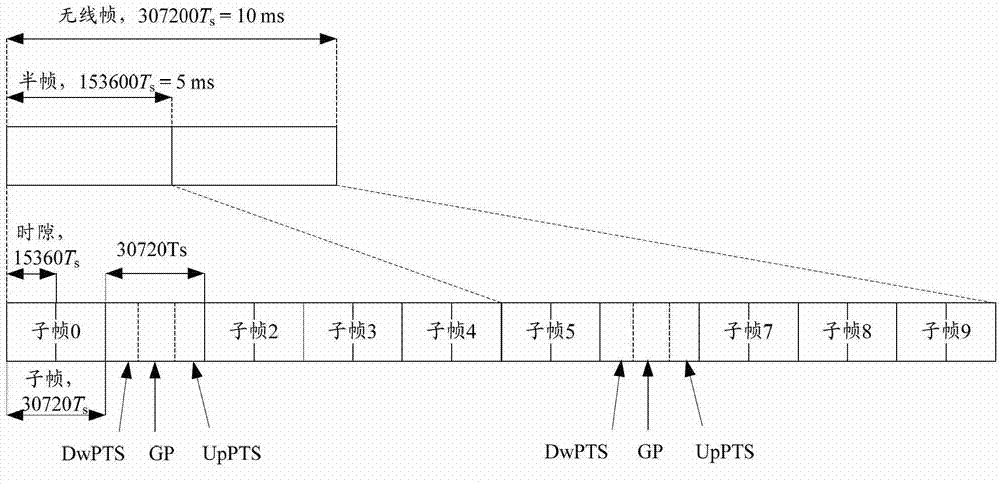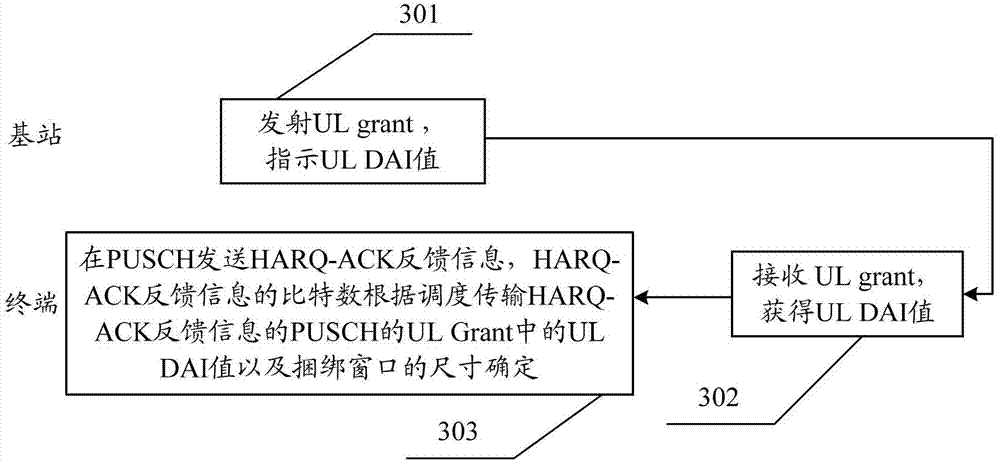Method for sending hybrid automatic repeat request-acknowledgement character (HARQ-ACK) feedback information
A technology of feedback information and number of bits, applied in signaling allocation, transmission path sub-channel allocation, error prevention/detection using return channel, etc., can solve problems such as adjacent frequency interference, and achieve the effect of avoiding waste
- Summary
- Abstract
- Description
- Claims
- Application Information
AI Technical Summary
Problems solved by technology
Method used
Image
Examples
Embodiment 1
[0064] Assume that the base station configures two CCs for the CA UE, namely the primary CC and the secondary CC. The primary CC is TDD uplink and downlink configuration 2, MIMO transmission mode, and the secondary CC is TDD uplink and downlink configuration 1, SIMO transmission mode, such as Figure 4 shown. The bundling window of the primary CC includes subframes {4,5,6,8}, the bundling window size is 4, the bundling window of the secondary CC includes subframes {4,5,6}, the bundling window size is 3, and the UL of PUSCH is scheduled Grant is sent on subframe 6 of the secondary CC, assuming UL DAI=2.
[0065] If the secondary CC is in SIMO transmission mode, then the number of HARQ-ACK feedback information bits of the secondary CC M_i=(min{M_b, UL DAI}+M_a)=min{3,2}+0=2;
[0066] The primary CC is in MIMO transmission mode, and the number of HARQ-ACK feedback information bits M i of the primary CC=2*(min{M_b, UL DAI}+M_a)=2*(min{3,2}+1)=6.
[0067] The UE is configured wit...
Embodiment 2
[0077] Assume that the base station configures 3 CCs for the CA UE, namely primary CC, secondary CC1 and secondary CC2, the primary CC is TDD uplink and downlink configuration 2, MIMO transmission mode, secondary CC1 is TDD uplink and downlink configuration 2, MIMO transmission mode, secondary CC2 It is TDD uplink and downlink configuration 1, MIMO transmission mode, such as Figure 7 shown. The bundling window of the main CC includes subframes {4,5,6,8}, the bundling window size is 4, the bundling window of the auxiliary CC1 includes subframes {4,5,6,8}, and the bundling window size is 4, the auxiliary CC2 The bundling window includes subframes {4,5,6}, the bundling window size is 3, and the UL Grant for scheduling PUSCH is sent on subframe 6 of secondary CC2, assuming UL DAI=3.
[0078] Secondary CC2 is in MIMO transmission mode, then the number of HARQ-ACK feedback information bits of secondary CC2 M_i=2*(min{M_b, UL DAI}+M_a)2*(min{3,3}+0)=6;
[0079] The primary CC is i...
Embodiment 3
[0092] Assume that the base station configures two CCs for the CA UE, namely the primary CC and the secondary CC. The primary CC is TDD uplink and downlink configuration 2, MIMO transmission mode, and the secondary CC is TDD uplink and downlink configuration 1, SIMO transmission mode, such as Figure 4 shown. The bundling window of the primary CC includes subframes {4,5,6,8}, the bundling window size is 4, the bundling window of the secondary CC includes subframes {4,5,6}, the bundling window size is 3, and the UL of PUSCH is scheduled Grant is sent on subframe 6 of the secondary CC, assuming UL DAI=2.
[0093] If the secondary CC is in SIMO transmission mode, the number of HARQ-ACK feedback information bits M i=min{UL DAI,M_b}+M_a=2 of the secondary CC, and the 2-bit HARQ-ACK information bits are directly transmitted;
[0094] The primary CC is in MIMO transmission mode, and the number of bits of the HARQ-ACK feedback information of the primary CC is equal to the value of UL...
PUM
 Login to View More
Login to View More Abstract
Description
Claims
Application Information
 Login to View More
Login to View More - R&D
- Intellectual Property
- Life Sciences
- Materials
- Tech Scout
- Unparalleled Data Quality
- Higher Quality Content
- 60% Fewer Hallucinations
Browse by: Latest US Patents, China's latest patents, Technical Efficacy Thesaurus, Application Domain, Technology Topic, Popular Technical Reports.
© 2025 PatSnap. All rights reserved.Legal|Privacy policy|Modern Slavery Act Transparency Statement|Sitemap|About US| Contact US: help@patsnap.com



